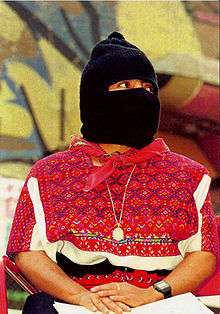Comandanta Ramona
| Comandanta Ramona | |
|---|---|
 | |
| Born |
1959 Chiapas, Mexico |
| Died | 2006 |
| Nationality | Mexican |
| Occupation | Revolutionary |
Comandanta Ramona (1959 – January 6, 2006) was the nom de guerre of an officer of the Zapatista Army of National Liberation (EZLN), a revolutionary indigenous autonomist organization based in the southern Mexican state of Chiapas. Perhaps the most famous female Zapatista actor, Ramona was one of seven female commanders in charge of directing an army that consisted of one-third women. A member of the Zapatista leading council, the CCRI (Clandestine Revolutionary Indigenous Committee), she served as a symbol of equality and dignity for indigenous and impoverished women.[1]
Biography
Ramona was born in 1959 in a Tzotzil Maya community in the highlands of Chiapas, Mexico.[2][3] Prior to joining the EZLN, Ramona earned a meager wage by selling artisan crafts. Tired of watching her impoverished community suffer, she joined the EZLN and became the voice of the many women who had been disregarded by the Mexican government for being seen as too small of a minority to influence public policy. This belief was later debunked after around 100,000 people turned out at the main square of Mexico's capital - proving that their presence in the country was big and that they were no longer going to endure laws that did not take their interests into account.[4]
Ramona took control of the city of San Cristóbal de las Casas, the former capital of Chiapas, during the January 1, 1994 Zapatista uprising. Ramona began a long fight with cancer the same year; in 1995, she received a kidney transplant,[5] which extended her life for over a decade.
In 1996, she broke through a government encirclement when she traveled to Mexico City to help found the National Indigenous Congress.[6] She was also the first Zapatista rebel to be granted government permission to travel outside of Chiapas for a three conference where she delivered the first of peace talks.[7] Ramona's peaceful demeanor and perseverance in her fight for the rights of her community turned her into an icon and symbol of equality.
Her last public appearance was at a preparation meeting—a plenary session for The Other Campaign—in Caracol de La Garrucha in the municipality of Francisco Gómez on September 16, 2005. After her death, Subcomandante Marcos suspended The Other Campaign activities for several days in order to be present at Ramona's funeral service.
Roots of feminist platform
Comandanta Ramona was not an ordinary soldier. The indigenous Maya of the Chiapas area shifted their political stances when the North American Free Trade Agreement (NAFTA) was first signed in 1994. This trade agreement required Mexico to welcome commercial agriculture and other foreign investment that would stress the land of the region, and threaten the cultural integrity of the people. NAFTA increased the autonomy that foreign corporations had in Mexico. Indigenous objections from members of EZLN, including comandantas such as Ramona emphasized the importance of these lands for subsistence purposes of the indigenous community. In addition, EZLN demanded to be part of any decision process where lands were discussed. EZLN was determined to establish a right to life and dignity against foreign corporations and the Mexican government alike.[8]
Due to their prior isolation from politics and their growing personal autonomy, indigenous women took matters into their own hands by creating the Revolutionary Women’s Law. In this law, Ramona helped outline the spaces that needed to be carved out for women both in the nation of Mexico and within their own indigenous communities.[9] The Revolutionary Women’s Law consisted of 10 laws including reproductive health facilities, access to technology and education, small business support, independent decision-making, not being physically, mentally and emotionally abused.[10] Indigenous women had been subjugated under a system of cultural, sexist and class beliefs. However, with the prompting and influence of leaders such as Comandanta Ramona, EZLN recognized the influence of women in their movement, and by the time of the signing of NAFTA one third of their military personnel were women.
Comandanta Ramona is renowned as one of the most iconic indigenous women of her time. She symbolized the truths behind being a pobre indigena in a primarily male dominated world where globalization increasingly challenged the autonomy of indigenous people.[11]
Legacy
Ramona was famous for her petite body frame masked and clothed in indigenous dresses. Vendors in her home town created a doll version of Ramona which consisted of a masked peasant woman usually carrying a gun or a baby.[12] Her words and activism continue to inspire women in Chiapas and beyond.[13]
See also
References
- ↑ Zwarenstein, Carlyn (January 11, 2006). "Legacy of a Zapatista Rebel". The Globe and Mail. p. 19.
- ↑ Queen of the Neighbourhood Collective (2010). Revolutionary Women: A Book of Stencils. Oakland, California: PM Press. p. 99. ISBN 1604862009.
- ↑ Amozurrutia, Alina (2008). 101 Mujeres en la Historia de México (in Spanish). Mexico City: Grijalbo. p. 301. ISBN 9708103284.
- ↑ "Comandante Ramona". The Independent. Retrieved 2015-11-23.
- ↑ Davidson, Phil (January 11, 2006). "Comandanta Ramona; Zapatista Rebel Leader Dies". The Independent. p. 37.
- ↑ Ross, John (March 19, 1999). "The Zapatistas are Back". LA Weekly.
- ↑ "LexisNexis® Academic & Library Solutions". www.lexisnexis.com. Retrieved 13 August 2018.
- ↑ Wolfwood, Terry (1997). "Who is Comandanta Ramona?". Third World Resurgence (84).
- ↑ Hansen, Devon; Ryan, Laura. "Teaching Women in the Zapatista Movement: Gender, Health and Resistance". World History Connected.
- ↑ "EZLN Interview with Commandante Ramona and Major Ana Maria, tr. C. Ross". www.freedomvoices.org. Retrieved 13 August 2018.
- ↑ Belausteguigoitia, Marisa (2006). "Ramona: El derecho a descansar" (PDF). Debate Feminista. 33.
- ↑ Wolfwood, Terry (August 1997). "Who Is Comandanta Ramona?" (PDF). Third World Resurgence No. 84,. Retrieved November 20, 2015.
- ↑ "Who is Comandanta Ramona?". Schools for Chiapas. 1997-03-20. Retrieved 2018-02-24.